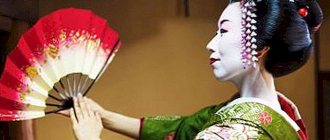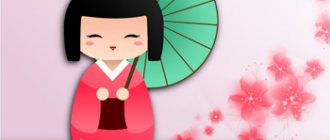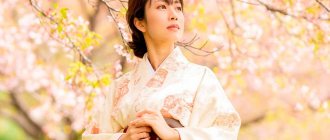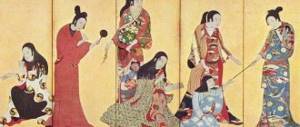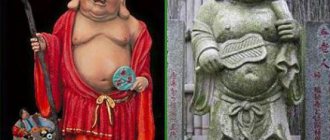Japanese sweets
Japan is an amazing country with a rich history. The Land of the Rising Sun has given the world a lot of interesting things, including unusual sweets. It's hard to believe, but they first appeared in Japan only in the 8th century. For dessert, the Japanese ate ordinary fruits, berries, chestnuts, and nuts. In addition, the world-famous mochi cakes were already invented back then.
Naturally, only emperors and other members of the elite could indulge themselves in such delicacies. On their dinner tables there were all kinds of dishes from the Middle Kingdom. Only from that time did the inhabitants of the Land of the Rising Sun begin to invent their own Japanese sweets. Such a tradition was finally formed only in the 12th century.
The main ingredient in Japanese sweet confectionery was "wagashi". Essentially, this is a paste that has a unique recipe and composition (take, for example, seaweed, beans and chestnuts). All this combined gives a rather unusual and extremely unusual taste for European residents.
Gradually, the “sweet” culture developed. Delicacies have become an integral part of holidays, tea ceremonies and similar events. In the homes of aristocrats it was customary to serve cakes with drinks. Their flavor went well with the mild bitterness of a good green tea.
A new stage in the development of Japanese sweets is associated with the advent of Europeans (for example, the Portuguese), who sailed to the Land of the Rising Sun in the 17th century. Their appearance to some extent influenced the local culture, but they also brought all sorts of goodies into the life of the Japanese, which were appreciated by the local residents. The Japanese decided to only partially borrow the recipes, and changed the dishes themselves in their traditional way. For example, the usual and familiar European sponge cake is the predecessor of doryaki, a dessert consisting of two flat cakes with a layer of beans between them.
In the 19th century, a lot of different sweet dishes were brought to the Land of the Rising Sun. This includes chocolate, cookies, caramel, etc. As a result, even more recipes for Japanese sweets and a new direction called “yogashi” appeared. As for the usual "wagashi", these goodies have not been changed. Local residents are proud of them and consider them one of the types of national culture, and therefore carefully protect and preserve the recipe in the form in which it was invented.
Features of yogashi
The main difference between these desserts is that they consist mainly of fruits and berries. The base is jelly, jam or marshmallow. Europeans prefer cream, chocolate and caramel. An important point is that the Japanese do not use butter or dairy products. Moreover, they do not suffer from sugar cravings. This is probably why these people are so slim and rarely suffer from obesity. In Japan, even sweet dishes are healthy for the body and can be considered dietary.
The famous poet Kenkichi Kusomoto once spoke about Japanese sweets:
1. It is important that they are not too sweet; 2. Attractive in appearance; 3. Made by hand.
Particular attention is paid to the second point, because the Japanese strive to serve food that is not only tasty, but also beautiful. This is their culture. This is probably why they use a soft base, as it is easier to work with.
Traditional and popular Japanese sweets
Some of the Japanese delicacies should be considered in more detail, because they have existed for many centuries and are still very popular. They personify an entire culture, and therefore deserve special attention:
1.Wagashi. Translated, this word means “Japanese sweets.” Today, wagashi is extremely in demand: both among local residents and tourists. That is why it is not difficult to find them in Japan. Wagashi are sold in ordinary street shops, cafes, restaurants and pastry shops. That is, they are found almost everywhere, as they are considered an integral part of the Japanese way of life. You can see wagashi at every holiday, festival and important event.
Wagashi consists of the following ingredients:
1) Rice mass (mochi);
2) Sweet red bean paste (anko);
3) Algae (agar-agar);
4) Additional components. These can be spices, soy flour, chocolate, nuts, berries and fruits.
Eggs, milk and butter are not used under any circumstances. You can add a little sugar, maple syrup, or corn syrup if desired;
2. Yokan was invented quite a long time ago, more than 1000 years ago. It is based on kanten, made from tengusa seaweed. Anko beans, sweet potatoes and roasted chestnuts can also be added. One of the main advantages of this Japanese sweet is its versatility and simplicity. That is why it can be seen in almost all shops and cafes;
3.Manju. You can find these cakes in almost all pastry shops in the country. They are small in size. The outer layer is made from rice dough and the filling includes anko beans. In some cases, the filling is made from sweet potatoes and grated chestnuts;
4.Dango. These are flatbreads that have been boiled in water or steamed. They are very tasty and everyone loves them, regardless of age. The main ingredient is mochigomeko rice flour. Several balls (usually 3-4) are served on a small wooden skewer. Anko sauce or soy green bean paste can be used as an accompaniment;
5.Kasutera. This is a biscuit that was brought by the Portuguese back in the 16th century. Its main difference is that it is somewhat harder and sweeter. As a rule, it is covered with a sugar crust.
Unusual Japanese sweets
There are a lot of traditional dishes and listing them all is quite problematic. However, even some representatives of Japanese delicacies can surprise gourmets.
1.Oshiruko. Of course, this Japanese sweet does not have a very familiar appearance, but it has a very rich taste. To some extent, it resembles mulled wine, because they also like to drink it during the cold season. It's basically a soup made from sweet adzuki beans. They are placed whole or crushed, and additionally seasoned with condensed milk or sugar. Typically, oshiruko is served with dango or mochi, although sometimes they are replaced with candied chestnuts or rice dumplings. Tourists can cook oshiruko themselves (if possible, since this process is quite labor-intensive, involving repeated boiling of the beans) or purchase it in canned form from vending machines. Naturally, this “soup” can only be found in Japan.
2. Amezaiku. These are animal-shaped lollipops. They were invented back in the 18th century. Lollipops came to Japan from China. Initially, they could only be found in Kyoto, but over time they became more and more popular. For some time, amezaiku had a not too complex shape and resembled traditional Russian cockerels. But the artisans learned and improved. In recent years, these beautiful products have begun to die out. The number of masters is decreasing all the time, so we can say that amezaiku is a rare and disappearing Japanese sweet, and, alas, not every lover of the Land of the Rising Sun will be able to try it;
3. Shigen moshi. This is a unique cake. Outwardly, it looks very much like a drop of water that is about to burst, but this is only a visual impression. This confectionery product is made from unique ingredients. It is based on water that was extracted in the Japanese Alps and agar-agar, which acts as gelatin. The delicacy itself has a rather delicate consistency. You can eat this unique creation with a simple spoon, but it’s better to hurry, as it will completely melt within 30 minutes;
4. Matcha flavored ice cream. Perhaps this delicacy is loved by all people without exception. There is nothing surprising here, because it really has a wonderful taste. However, the Japanese managed to come up with something extraordinary and traditional here (for themselves, of course). Matcha is a powdered green tea used in classical ceremonies and is also a flavoring agent for many Japanese sweets. It is not difficult to find, because it is very popular, and the ice cream itself has an unusual taste, but it has a lot of benefits.
Japan differs from Russia and any European country not only in its cuisine, but also in many other things. You can learn about preparing for a trip to Japan from our master class on traveling to Japan, and improve your language skills in our main course for beginners.
Of course, these are not all the Japanese sweets that exist in the Land of the Rising Sun. There are a lot of them and it is simply unrealistic to list them all in one article. Perhaps you, dear readers, know some interesting dishes or have even tried something unusual? We look forward to your comments on this matter.
We recommend:
Castella | Castella
A very delicate sponge cake with Portuguese roots. is called Kasutera . The cake, covered with a characteristic sugar crust, does not have quite the taste that you expect from a sponge cake. This Japanese sweet contains honey, green tea powder, and special syrup. Castella is easy to take home: it is packaged in narrow oblong boxes and is sold in almost all supermarkets.
Mochi | Mochi
Strictly speaking, this is not really a dessert. Mochi in Japan is a special rice dough, on the basis of which many national dishes are prepared. Including sweets. By "mochi" we mean a whole group of desserts that are worth trying in Japan. Among them are soft steamed buns with a sweet filling that look like colored khinkali, as well as mochi ice cream with a variety of flavors, and dango - balls on skewers in syrup. Bring home original mochi candies - soft, colorful, with unusual flavors.
Manju | Manju
These national sweets are a must try in Japan. Manju is a baked pie or cake made from sweet flour (rice, buckwheat or wheat). The filling can be anything: chocolate, cream, adzuki bean paste, fruit jam, sweet cheese or something else. The most popular sweet in this category is green manju-matcha (with the addition of matcha tea). In Hiroshima, the dessert is traditionally baked in the shape of a maple leaf; it is difficult to find anywhere else. If you decide to buy a set of manju in Japan as a gift to your loved ones, carry it in your hand luggage.
Taiyaki | Taiyaki
Be sure to try this sweet in Japan and bring a couple of boxes for your friends. The famous Japanese fish-shaped cookies are one of the main traditional desserts of the country. In its classic version, it is made from unleavened dough filled with sweet adzuki bean paste. For tourists there are options with chocolate or custard. However, today unusual Japanese sweets are becoming increasingly popular: taiyaki with sweet cheese, okonomiyaki vegetable or fish cake, meat paste or other original fillings.
Sakura-mochi | Sakura Mochi
During cherry blossoms in Japan, you can try unusual pink sweets. It is during this season that they are easy to find in almost every cafe. However, the recipe is traditional, so if you wish, you can find the dessert in Japan at any time. Sakura mochi are rice balls filled with adzuki bean paste and wrapped in pickled sakura leaves. An interesting combination of sweet and salty, a slight spiciness of the marinade - very unusual, but really tasty. You can buy marinated sakura leaves to take home. They are sold in plastic packaging.
Yekan | Youkan
An unusual marshmallow based on a sweet paste of beans, seaweed and agar-agar. The consistency of the dessert resembles something between marshmallow and marmalade. Be sure to try these Japanese sweets: classic or with the addition of persimmons, sweet potatoes, figs, matcha tea - there are many options. Ekan can be brought from Japan in a box: marshmallow sticks + round sweets or one thing or the other. Try it in the form of cakes on the spot.
Sembei | Sembei
These are crispy rice crackers that the Japanese bring as gifts to foreigners, as they consider them a win-win dessert. Flavors come in a variety of flavors: chocolate, nuts, sesame, anko paste, as well as crab, soy sauce, nori, wasabi or something else. Spicy and salty senbei is also considered a dessert in Japan. The most popular type of this sweet is with matcha green tea. You can bring home an assortment of crackers in a large box.
Daifuku | Daifuku
This Japanese sweet is divided into several subtypes, each of which is worth trying. The base is rice dough, the second layer is anko bean paste or cream, the filling is large pieces of fruit, whole berries or creamy fruit. If you try daifuku in a cafe in Japan, you will be served the dessert in the form of a ball the size of a large apricot. And if you decide to buy this Japanese sweet in a store, you will find candies the size of a walnut or a small hazelnut. Of course, it is better to take the latter option home and always in individual packages.
Dorayaki | Dorayaki
Miniature fluffy pancakes with a sweet filling are the leader of Japanese sweets according to positive reviews from tourists. The layer is usually sweet bean paste, chocolate or berries. Freshly prepared dorayaki is best eaten warm. In factory packaging, they sometimes look like French macarons: colorful, airy, with a contrasting layer. However, it tastes more like a biscuit. They often depict the famous blue cat Doraemon. Dorayaki are easy to bring home: buy those in individual packages. And be sure to try the Japanese KitKat with dorayaki flavor.
